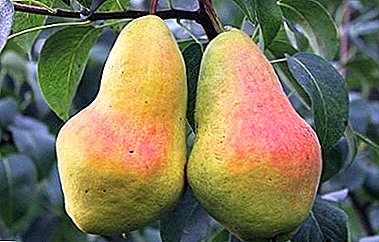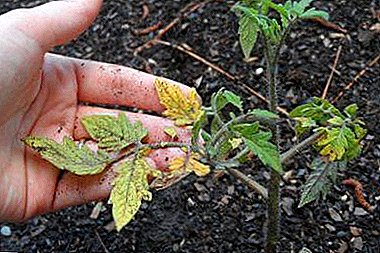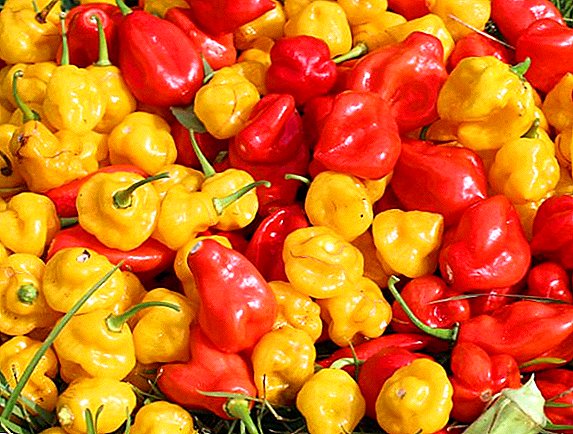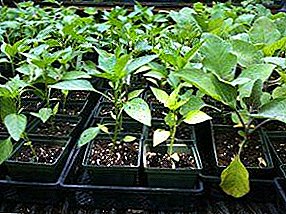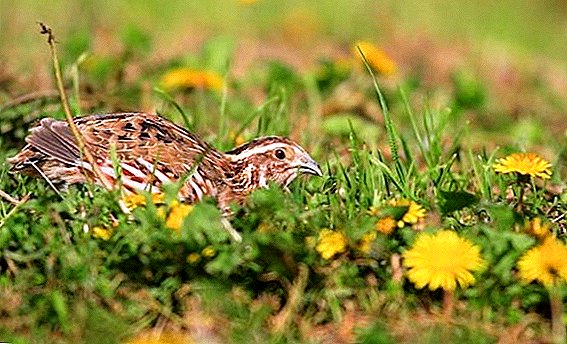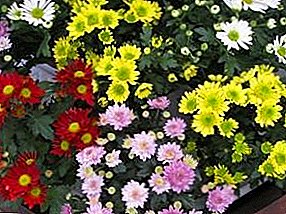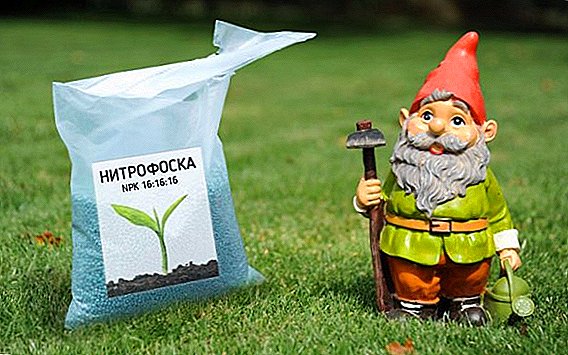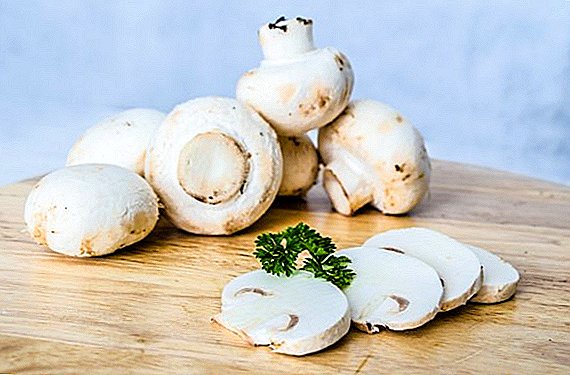 In the spring, with the beginning of garden and gardening works, gardeners pay special attention to the cultivation and distribution of seedlings of peppers, eggplants, cabbage and, of course, tomatoes. On one of the best varieties of tomatoes, which is called "Skorospelka", and will be discussed in our article. We will understand all the subtleties of the choice of seedlings, self-cultivation in the open field, the rules of fertilizer and the prevention of various diseases.
In the spring, with the beginning of garden and gardening works, gardeners pay special attention to the cultivation and distribution of seedlings of peppers, eggplants, cabbage and, of course, tomatoes. On one of the best varieties of tomatoes, which is called "Skorospelka", and will be discussed in our article. We will understand all the subtleties of the choice of seedlings, self-cultivation in the open field, the rules of fertilizer and the prevention of various diseases.
Variety description
Tomato variety "Skorospelka" is early and can be grown equally well in open ground and in closed, that is, in a greenhouse. Outwardly, this representative of garden crops has a high branched stem and a large amount of ash-green fleshy foliage.
Such a variety of tomatoes needs additional pinching and tying up to strong supports, since its height sometimes reaches 1 meter. At the same time, due to the fact that this subspecies is an early one, an insignificant number of tomatoes grow on one bush.
Check out the description and farming practices of growing such early tomato varieties as "Samara", "Bokele F1", "Kiss of Geranium", "Caspar", "The King of the Early", "Lyubasha", "Gina", "Aelita Sanka", "Big mommy "," Little Red Riding Hood "," Riddle "," Masha F1 Doll "," Aphrodite f1 "," Labrador "," Bokele "," Alsou "," Ladies Fingers ".
Its average fertility is 6-7 fruits per branch. The flowers are simple, similar in shape to small bells, have a bright white color with a yellow base. 
The advantages of this variety are:
- Large capacity of beneficial vitamins, microelements and minerals in fruits that can perfectly fill the lack of usefulness in our body and in a very short time. It is "Skorospelka" that most often gets first on the shelves of bazaars and shops and is widely used by gardeners for commercial purposes.
- Resistance to temperature changes characteristic of April and May, during which this variety of tomatoes gains strength and growth.
- Immunity to various kinds of diseases, but does not face blight due to the fact that it has time to mature before its appearance and progression in the summer months.
Among the shortcomings of the variety include the need for pinching and tying, and still low yields. 
Did you know? La Tomatina (Spanish: La Tomatina) is an annual festival in honor of tomatoes, which has become an integral symbol of the city of Bunol, which is part of the autonomous community of Valencia. This festival takes place in the twentieth of August. Tens of thousands of visitors from all over the world take part in it. The main entertainment of the holiday is the fair and the so-called "battle of tomatoes", where people use tomatoes as improvised weapons.
Fruit characteristics and yield
The fruits of this sort of tomato fully ripen already on the 85th day from the day of sowing the seeds and reach about 150 g of weight. Such tomatoes are distinguished by a rounded, slightly flattened form at the ends. When ripe, one side of the tomato has an orange tint, while the rest of the fruit has a uniform red color.  It is fleshy, moderately sour, and sometimes a little sweet, has an appetizing flavor. These tomatoes are great for fresh consumption, as well as for squeezing tomato juice and preservation.
It is fleshy, moderately sour, and sometimes a little sweet, has an appetizing flavor. These tomatoes are great for fresh consumption, as well as for squeezing tomato juice and preservation.
Its fruits do not burst from high temperature and have excellent storage and transportation indicators, because they are practically not damaged due to their high density and fleshyness. The average is considered an indicator of yield of 5-7 kg per 1 sq. Km. m landing area.
Did you know? In the world there are more than 10,000 different varieties of tomatoes. Interestingly, the size of the fruits of the smallest variety reaches 2 cm in diameter, and the weight indicators of the largest variety of tomatoes sometimes exceed 1.5 kg.

Selection of seedlings
If you do not burn with the desire to spend a long and painstaking process of self-growing tomatoes from seeds, then the rules for choosing a good seedling will be more useful for you:
- The age of seedlings should not exceed 60 days. The best option will be young saplings from 45 days from the time of sowing. You should also be guided by the rule of planting seedlings of the same age on one bed, so that their growth and development are uniform, because the neighboring plants protect each other from the scorching rays of the sun, and if they grow unevenly, then such natural protection will not work.
- The height of seedlings should not exceed 30 centimeters, and the number of leaves varies in the range of 6-8 pieces.
- The stem of the seedlings should be thick and elastic, it can be compared with a pencil. Also on the trunk, leaves and roots should not be visible damage. The seedling should be symmetrical with a well-developed and compactly formed root system. In the presence of the slightest mechanical damage to buy seedlings is not worth it.
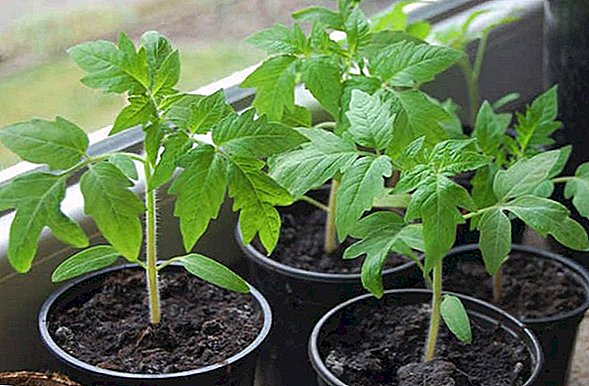
- Before you buy seedlings, carefully inspect the leaves and stems for laying various pests. Especially carefully review the backs of the leaves and the attachment of the branches to the trunks, because it is there that most often you can find small insect eggs. The same rule of preliminary inspection applies to leaves that have holes on their surface or have been twisted or deformed. Such flaws indicate the affected state of the plant.
- All seedlings should be in boxes with the ground. It is not worth buying seedlings from the seller who keeps them in bags, since this type of packaging has a negative effect on the root system, preventing its normal and rapid rooting on the lot.
Important! Often in the markets one may encounter dishonesty of sellers, accelerating the growth of their seedlings with the help of abundant nitrogen fertilizers. To distinguish such poor quality seedlings can be overly intense green color and leaves, the ends of which are wrapped inside.Video: how to choose tomato seedlings Guided by these basic rules, you can choose high-quality and healthy tomato seedlings. It is advisable to buy it only in proven places. But even if you are buying seedlings for the first time, our recommendations will help you avoid failure.
Growing conditions
For the successful cultivation of tomatoes, it is necessary to observe a number of conditions, including the correct light and temperature conditions, and the observance of humidity.
Lighting
It is no secret that a tomato is a great lover of light and heat. So, when it is grown, the rule is: the brighter and more intense the light, the more actively the crop matures. With a temperature indicator of + 14 ... +16 degrees, tomato seeds begin to germinate, but the most favorable temperature is + 20 ... +25 degrees.
At that moment, when the level of the thermometer drops to +10 degrees, the development and growth of tomatoes slows down significantly, and if the temperature continues to drop, then it stops altogether.  If the level of the thermometer fell to -1 degree, then the plant dies. The lack of light causes stretching and weakening of the tomato bushes, delaying the beginning of their flowering and fruiting.
If the level of the thermometer fell to -1 degree, then the plant dies. The lack of light causes stretching and weakening of the tomato bushes, delaying the beginning of their flowering and fruiting.
In addition to temperature, the humidity regime is important in growing tomatoes. The most balanced and positive for Tomato "Rapia" will be the air humidity in the range of 45-60%, and the soil moisture should vary from 65 to 75%. In such conditions, growth and development of tomato will be the best way.
Fertilizer
The fertility of the soil cover also has a considerable influence on the formation of the future tomato, because the lion's share of all the beneficial trace elements and vitamins is taken from the soil.
Feeding tomatoes as follows:
- During the period of formation of the root system, it is necessary to increase the concentration of phosphorus in the soil by applying special fertilizers.
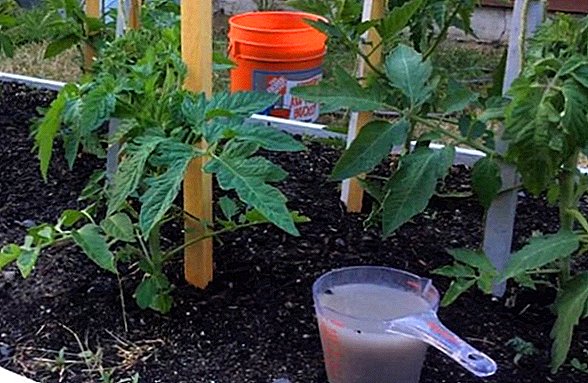
- Then, at the stage of fruit formation, phosphorus should be combined with potassium, which will contribute to accelerated flowering, fruit ripening and increasing plant resistance to diseases.
- Particular attention should be paid to nitrogen fertilizers, with which you need to be extremely careful and follow the dosages prescribed in the instructions. An insufficient amount of nitrogen will negatively affect the tomato: growth will slow down, the leaves will turn pale or even fall, and the fruits will be small and with defects. At the same time, excessive nitrogen content in the soil provokes excessive growth of deciduous mass and stems, which will lead to lower yields and a slower fruit formation.
We recommend reading about what types of soil exist, how to improve soil fertility, how to independently determine the acidity of the soil at the site, and also how to deoxidize the soil.
Sandy and loamy soils are considered the best for tomatoes of this variety, where the pH value varies in the range of 5-6. Under such conditions, the ripe harvest begins to gather on the 30th day after flowering. 
Predecessors
If we talk about the precursors of tomatoes, which grew on the site last season, then the best are the cabbage, cucumbers and all kinds of legumes, which grew on open and heated by the sun land fragments.
Important! Potatoes are an unacceptable precursor for any variety of tomatoes. You should also abandon the planting of seedlings in the vicinity of potatoes. The thing is that both tomatoes and potatoes belong to the family of the Solanaceae, and therefore their diseases and pests are the same. Placing crops next to you puts them at additional risk, since if potatoes are hit, tomatoes are likely to be hit, and vice versa.

Pre-planting of green manure crops, such as peas, will have a positive effect on the growth and development of tomatoes. It should be sown in autumn towards the end of October. In the spring for 10-15 days before the start of work with seedlings, green peas should be mowed, chopped and prikopat in the soil. So you additionally fertilize the site with all necessary organic matter.
Seed preparation and planting
The first and important issue in dealing with seeds is their proper preparation and determination of the period of their planting.
Seed preparation
Tomato seeds can be sown both in dry form and after pre-soaking.
For soaking, you can use the following methods:
- Instead of simple water, it is better to soak the seeds in a weak solution of potassium permanganate (manganese ore at the tip of a knife for 1 liter of water). Potassium permanganate will produce a disinfecting and disinfecting effect.
- A solution of ash is considered to be a rather effective germination accelerator when 2 tablespoons of ash are dissolved in a liter of boiling water and left to stand for two days.
- If it is difficult for you to find the ashes, you can use special preparations that are sold in gardening stores and on the Internet. It will be effective to apply "Fitosporin-M", at the same time improving germination and increasing the protective function of tomato against various diseases. If you treat the seeds "Fitosporin-M", then they can not soak in potassium permanganate.
Landing on seedlings
In order to correctly determine the time when it is necessary to carry out the sowing of seeds of tomatoes on seedlings, you can use the following arithmetic method:
- The starting point will be the estimated time of planting the finished seedlings into the ground. It largely depends on which region you live in, whether you will use a greenhouse or immediately place the seedlings on open ground, as well as on what spring (early or late) is predicted, and on a number of other factors.
- The next step will be the subtraction from this estimated date of the respective age of the seedlings: 40-50 days for early varieties.
- It is also worth deducting another 5-6 days to be spent on seed germination. In this process, you need to remember about the optimal temperature, which should not fall below +24 degrees. As a result, you calculate the date when you should be sowing.
We advise you to read about how to choose the optimal time for planting tomato seedlings, as well as how to germinate and how to plant tomato seeds.
But if you determine the date uncertainly (that is, the expected date will be stretched for a week or two), then it is better to wait a bit, because it is known that overgrown seedlings take root much worse in a new place. 
Pick and sprouting
As a container for sowing seedlings it is convenient to use small-sized boxes or plastic containers (in general, food containers are also suitable). Putting off a pick on the back burner is not worth it. Already on the 15-21st day, seedlings of tomatoes can be swooped down.
During planting, tomatoes should be buried to the cotyledonary leaves and pritenite from the sun on the window for a couple of days so that the shoots can adapt after transplanting.
Read more about how and when to pick the tomatoes correctly after germination.
For the successful germination of tomato seedlings at home, you need to create a comfortable environment, among which, first of all, the temperature regime. So, in the daytime you need to maintain the temperature in the range of + 20 ... +25 degrees, and at night the minimum threshold will be +18 degrees.
Video: tomato picking If the early spring is cloudy, then the natural daylight will not be enough, and therefore you will have to additionally illuminate the seedlings with fluorescent lamps, because tomatoes are very light and heat-loving plants.
Watering seedlings
Watering seedlings should be treated with moderation, because too abundant watering can lead to the emergence and development of such a disease as a black leg. Always wait for the moment when the soil cover dries out, only then can a new watering be done.
Similar rules apply to various kinds of fertilizers. They also should not be abused, because the purchase of the soil already contains all the necessary nutrients, and therefore you can not make additional fertilizer. Remember that an excess of beneficial micronutrients and vitamins is just as harmful as a deficiency.
Make sure that the seedlings look healthy, the stem is strong, the leaves are strong and fleshy, the characteristic dark green color. If all these indicators are in order, then no tomato fertilizer is needed. 
Important! Begin to harden the seedlings, preparing it for planting in open ground, you need to advance, about one to two weeks before this event. When the thermometer will steadily show +10 degrees, you can take out seedlings to the open air. It is recommended to choose sunny places for hardening seedlings, so that young plants get accustomed to sunlight, because it is stressful for them.
Maintenance and care
To carry out proper care of tomatoes, you will need to adjust the mode of watering, feeding, weeding, know the rules of tying, hilling and methods of prevention and control of various pests and diseases.
Fertilizer
As a fertilizer, you can use any special mixture with one condition: there should be more potassium and phosphorus in them than nitrogen. Such fertilizer can be applied no more than once every two weeks, and no less than three times per season.  You can also spill shoots of chicken droppings dissolved in water. If we talk about mineral fertilizers, then particular attention should be paid to mixtures that include boron and magnesium (for example, you can use a solution of boric acid, which is prepared at the rate of 1 g per 1 liter).
You can also spill shoots of chicken droppings dissolved in water. If we talk about mineral fertilizers, then particular attention should be paid to mixtures that include boron and magnesium (for example, you can use a solution of boric acid, which is prepared at the rate of 1 g per 1 liter).
Tying up
Another important stage in the care of tomatoes will be the tying period. This operation should be carried out already when the plant gained strength and threw out 6-7 leaves, that is, almost immediately after transplanting into the ground.
It will be useful for you to read about how and why to tie up tomatoes in open ground and in a polycarbonate greenhouse.
This can be done in two ways:
- tie each bush to a separate peg, which is driven in at a distance of 10 centimeters from the stem on the north side;
- use the trellis, which includes rare retaining posts, between which the wire is stretched.

The second method is a little more convenient and practical, since plants are tied to one trellis in pairs from two rows at once. Thus, the passage between the rows is freed, making it possible to conveniently harvest.
Experienced gardeners claim that when tying to a trellis in most cases, the fruits of tomatoes are slightly larger than when they are solely tied up.
Hilling of tomatoes should be carried out 2-3 times per season, and weeding and removal of weeds should be done regularly from the very moment of planting in open ground until the garden is planted in the fall.
Did you know? As a result of research conducted by the World Health Organization, it was found that regular consumption of tomatoes, juice from fresh tomatoes, canned tomato juice, fresh and canned tomato paste or ketchup, as well as other sauces based on red fruits can significantly reduce the possibility of oncological diseases. .Video: garter and strawing tomatoes
Masking
Gotting is carried out a week after planting the seedlings in open ground. Depending on the shape of the bush you want to create, all the side stepsons are removed before they reach a length of 3-4 centimeters. If the process is longer, then its removal can cause undesirable consequences and the death of the plant.
Watering tomatoes after planting
As for watering, tomatoes do not need to make excessively frequent water. The best ratio will be to water them once a week in case of drought, and less often if it rains.
Find out whether it is possible to grow tomatoes without watering, and also how to properly and how often water the tomatoes in the open field and the greenhouse.
After each watering, you need to wait until the top layer is taken by the crust, and then it is possible to soil the plant around the plant to avoid the formation of a “stone” crust, which can damage the stem and the roots.  The most effective is the method of drip irrigation, when a small amount of moisture is constantly present under the plants. With such water intake, the early-ripening tomatoes give a slightly higher yield, and the fruits are even more fleshy and elastic.
The most effective is the method of drip irrigation, when a small amount of moisture is constantly present under the plants. With such water intake, the early-ripening tomatoes give a slightly higher yield, and the fruits are even more fleshy and elastic.
Disease and pest prevention
Tomatoes belong to the category of garden crops, which is of great interest among many insects, and also subject to a number of diseases. Such a negative point did not pass by the variety "Skorospelka".
You will probably be interested to read about how to deal with dangerous diseases and pests of tomatoes.
Below is a list of the most common diseases of tomatoes and methods of dealing with them.
- Strick. It differs in that the affected plants have twisted and sluggish leaves, all fruits and flowers fall, and sometimes the plant itself dies. To prevent such a virus from infecting a tomato, it should be planted in a sunny place and away from other plants of the Solanaceae family.
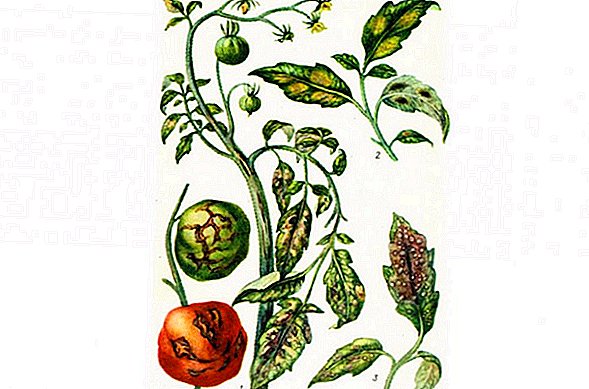
- Verticilous wilting. Bottom leaves begin to turn yellow, dry and fall. You can also see the twisting of the leaves and the cessation of plant growth, but death does not occur. Prevention can be timely fertilization and removal of all plant residues (including cut weeds) from the site. If such a lesion occurs, the diseased plants should be removed to prevent further infection.
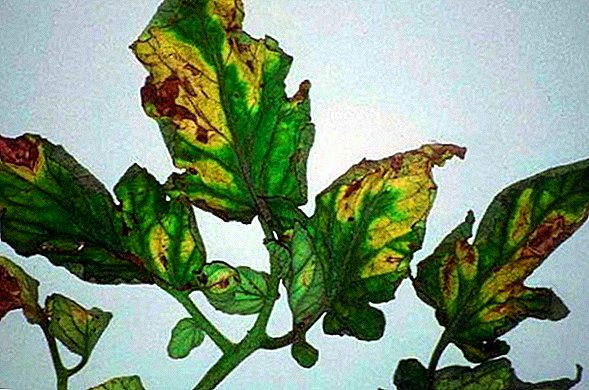
- Cracks on the surface of tomatoes are due to too much moisture, especially if before that there was a drought. Cracks are dangerous due to infectious lesions that cause rot. To save the fruits you need to make watering regular.
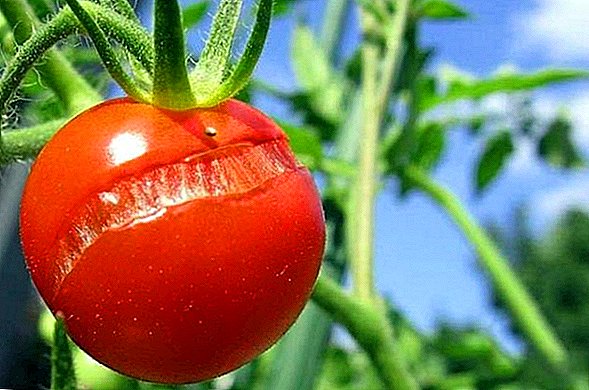
- Late blight. Multiple brown spots of putrefactive lesions appear on the whole body of the plant, and whitish bloom covers the bottom of the plant. Prevention of phytophthora: timely fertilization and respect for the neighborhood rules (can not be planted next to potatoes and other Nightshade). In the event of illness, all the tomatoes are sprayed with the drug "Barrier", and a week later, the "Barrier". From folk remedies helps infusion of garlic (5 crushed cloves on 1 liter of water).
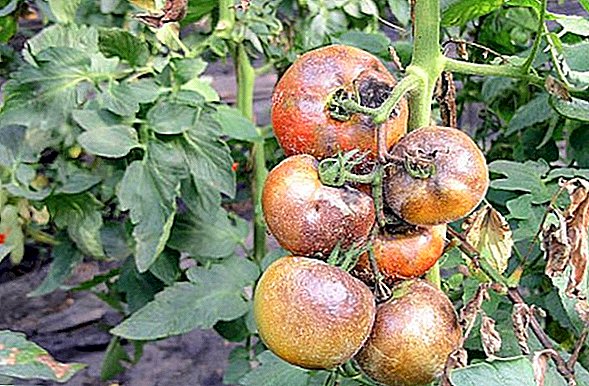
- Fomoz. The fruits of tomato are affected by large purple stains up to 3-4 centimeters in diameter. The affected place seems to be concave, because the putrid processes penetrate the inside of the tomato. This disease contributes to excessive moisture. If such a disease is detected, the affected fruits are removed and the bushes are sprayed with Khom, Oksikh or Bordeaux mixtures.

Did you know? The secret to watering tomatoes, which will significantly reduce the frequency and susceptibility to diseases, as well as increase their growth rate, is to add a few handfuls of ash to a bucket of water. And the sub-soil of the soil around the stem at the rate of one handful per 1 sq. m
- Bacterial spotting. Leaves (bruised by small brown spots) and fruits (large depressed dark spots, around which a bright border is formed) are affected. Dangerous complete destruction of the plant. Processing is performed with a solution of Bordeaux mixture, copper sulfate. Prevention is the timely application of fertilizers, which should include copper and nitrogen. Faded bushes are removed.
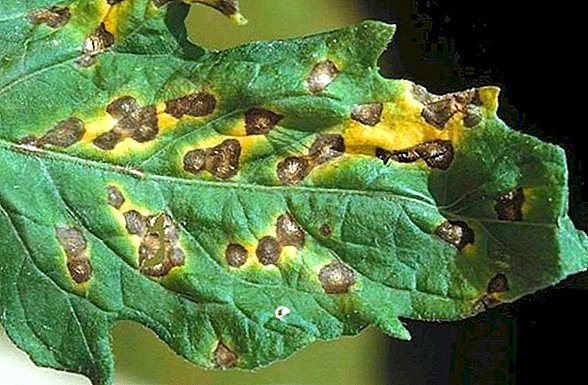
- Blackleg. This disease is more common among seedlings and young plants. The bottom of the stems is covered with black spots, and the plant dries. Tomatoes should be watered moderately. For prevention, the bushes can be shed with a solution of potassium permanganate (1-1.5 g of dry matter per 10 liters of water).
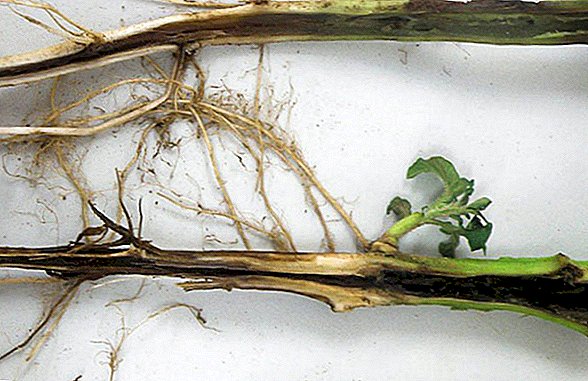
- Whitefly. This insect, whose name completely describes the appearance, covers the greenery of the tomato with secretions, due to which sooty fungi begin to develop, as a result of which the bush becomes black and dies. We recommend to fight pest with the drug "Confidor".
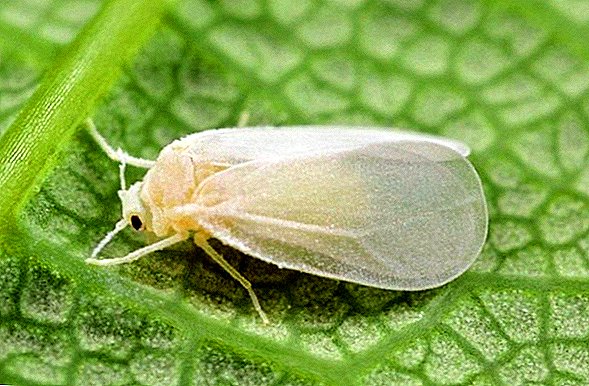
- Slugs Destroy the leaf cover, contribute to the appearance of rot on the fruit. To fight using ash, tobacco dust or slaked lime, which is sprinkled on the ground around the stem.
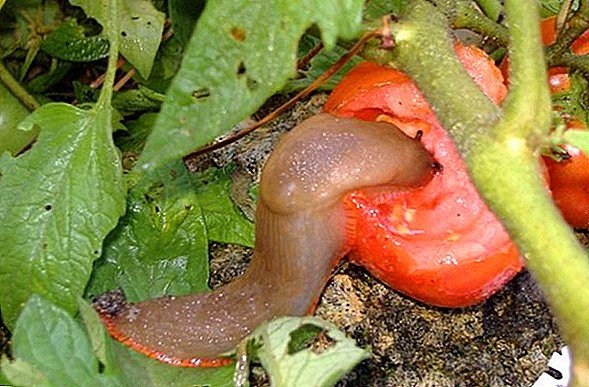
- Spider mite Having entangled the leaves with cobwebs, drinks juice from them, contributing to the drying and further death of the plant. To fight, use "karbofos" or folk remedy in the form of garlic infusion.
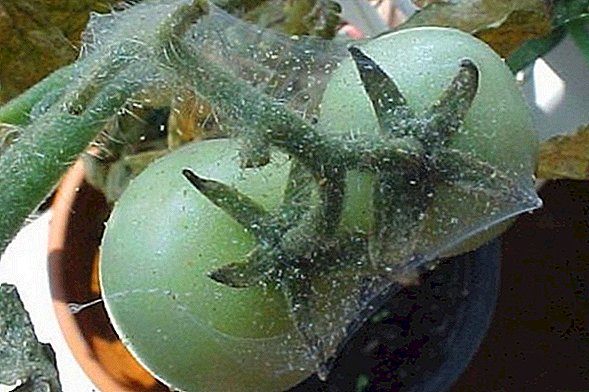
- Medvedka. Destroys the roots, contributing to the death of a tomato. For the fight used the drug "Thunder" or a folk remedy in the form of bitter pepper infusion with vinegar.
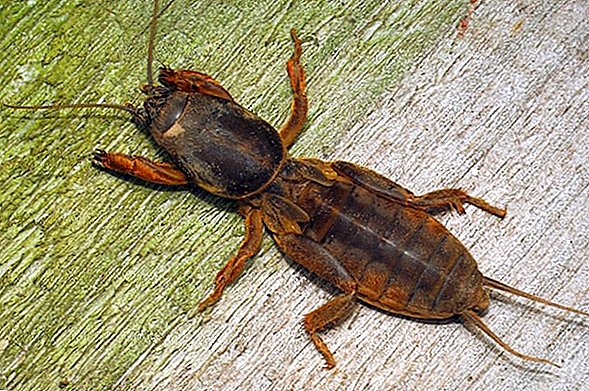
- Wireworm. This bright yellow larva eats the roots of a tomato, often delving into the stem. In order to combat recommended to use the drug "Basudin".
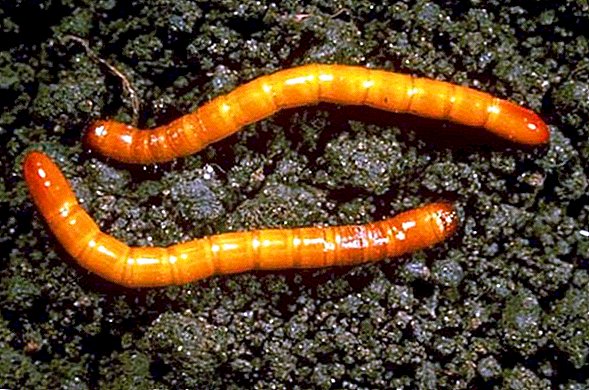
- Gnawing scoops. This caterpillar of dark gray or black destroys the leaf cover and the stems of tomatoes. To defeat them, tomatoes are sprayed with Strela.
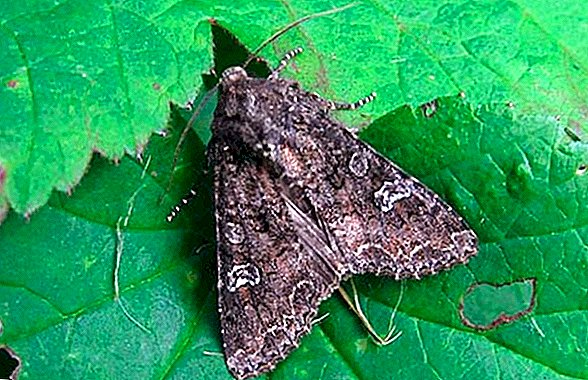
Harvesting and storage
Depending on the purpose for which you intend to harvest tomatoes, the harvest is red, pink, yellow, green or milky (the color depends on the maturity stage).
So, the red tomatoes of the "Skorospelka" variety are used in food, for the preparation of vegetable salads, for mashing tomato juice and pasta, as well as for preparing canned tomatoes.
The rest of the forms can be artificially ripened, which also determines their shelf life (it is significantly higher than that of ripe tomatoes). Also green, dairy and pink fruits are used for salting in a wide variety of recipes.
The first ripe tomatoes of this variety will appear already on the 80-90th day from the day of sowing the seeds. These tomatoes should be stored in plastic or wooden boxes, guided by the rule of not more than 12 kg in one container.  Sort "Rapid" is fleshy and elastic, and therefore tomatoes do not choke in the boxes and for a long time will be able to retain their original shape. Still, you should not forget about the harvest already harvested. These tomatoes should be eaten or processed within the next week from the day they are picked from the bed.
Sort "Rapid" is fleshy and elastic, and therefore tomatoes do not choke in the boxes and for a long time will be able to retain their original shape. Still, you should not forget about the harvest already harvested. These tomatoes should be eaten or processed within the next week from the day they are picked from the bed.
Read more about how and where to store tomatoes, why not keep tomatoes in the refrigerator.
To transport this variety of tomatoes is also easy, because they do not choke and do not let the juice because of their characteristics. The only thing that should be considered before putting the tomatoes in the boxes is an inspection for mechanical and insect damage. If they are identified, the affected fetus cannot be laid in the same box with the others.
It would be better to sort and slightly spoiled fruits to be the first to be eaten or processed, and only the best, dense and resilient to be sent for longer storage. An optimal storage place can be any dark and cool place that a basement or storeroom can become. 
Important! You can not store tomatoes in a room with high humidity, because it will contribute to the appearance and development of fungal and putrid lesions. If you store tomatoes in a cellar or storeroom, then provide them with ventilation, for example, by leaving the doors open.
Now you know all the subtleties of growing, protecting and collecting early varieties of tomatoes Skorospelka. Thanks to its characteristics, in June you will be able to enjoy its unique, fleshy and fragrant texture, while at the same time saturating your body with a variety of beneficial vitamins, minerals and trace elements.

















